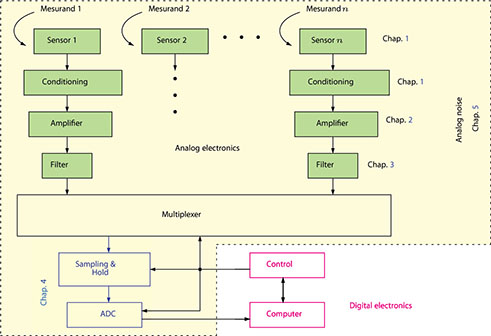Introduction
I.1. Purpose
A measuring system is a coordinated ensemble of different devices allowing a measurement operation through their interaction.
Thanks to its intrinsic flexibility, electronics is a powerful tool available to measurement science. This book is therefore dedicated to the exploration of several recurrent problems in this context, for what concerns the analog part of the measurement chain. We try to follow the usual analog signal path through a general acquisition chain and we describe the elements most frequently found there, with a level of generality sufficient to be useful in different domains (physics, biology…).
Figure I.1 shows the most traditional and general organization of a complete acquisition system from the sensor to the data storage system. Every measurement operation starts with a goal, which is the determination of a quantity (temperature, gas pressure, electric signals from heart beating, etc.). This quantity is called the measurand.
The sensor has the role of translating the measurand into an electrical quantity. If needed, the latter is in turn transformed into a voltage by a signal conditioning system. Chapter 1 describes the most used classes of sensors along with some classic conditioning strategies.

Figure I.1. Functional organization of a very general acquisition system. Shaded elements are treated in this book, in the chapters indicated ...
Get Analog Electronics for Measuring Systems now with the O’Reilly learning platform.
O’Reilly members experience books, live events, courses curated by job role, and more from O’Reilly and nearly 200 top publishers.

